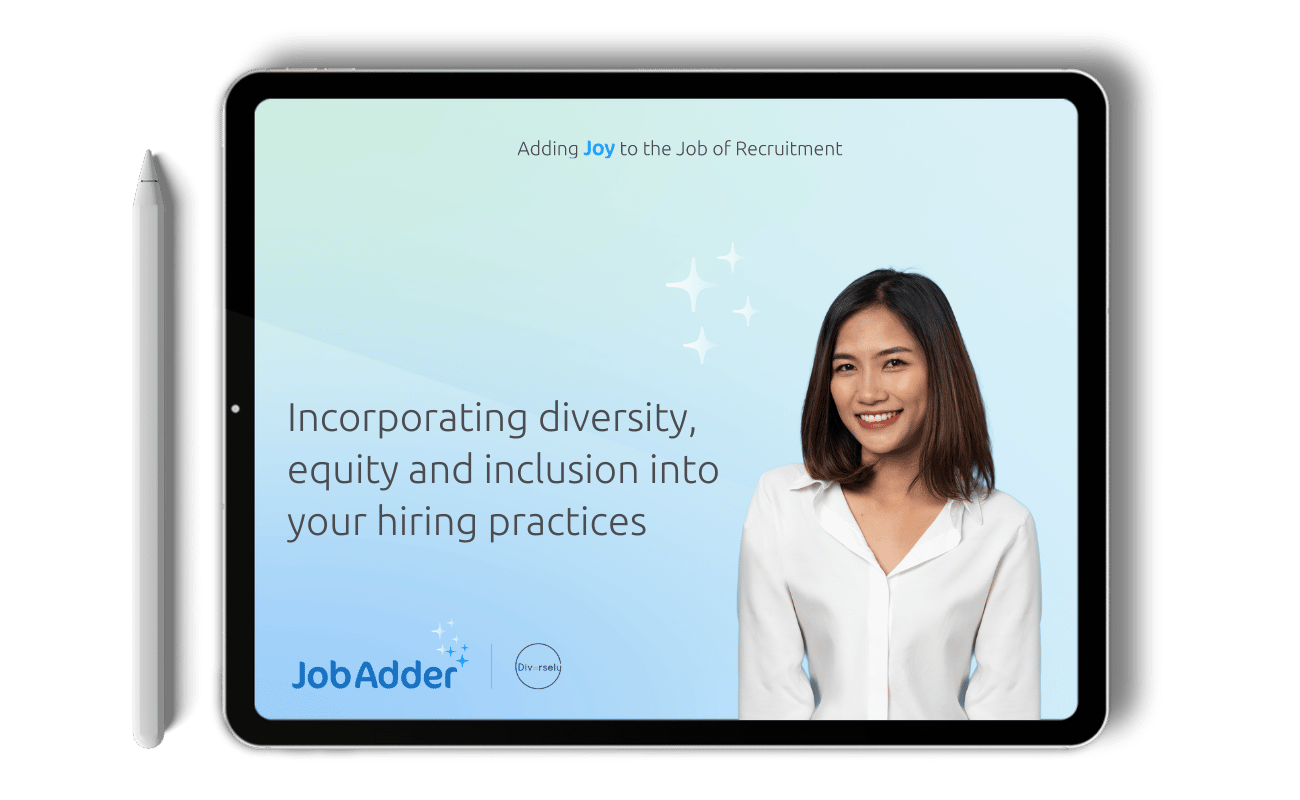Recruitment Blog
Top 8 ways to meet your diversity hiring goals throughout the hiring process

In the recruitment industry, diversity recruiting and hiring has become a top priority among many companies and hiring teams.
Building a diverse team has a lot of clear business and culture benefits within the workplace and it’s become more important than ever.
Recruiters and hiring managers must implement diversity hiring strategies to nurture an environment that values diversity, ethnicity, and inclusivity.
In this blog, we’ll go over what exactly diversity hiring is and the top ways you can improve your hiring practices to be more inclusive and jumpstart diversity initiatives.
FREE EBOOK: Incorporating diversity, equity and inclusion into your hiring practices
What is diversity hiring?
Diversity hiring refers to a company’s efforts to provide an equal opportunity to all applicants. It ensures that you hire qualified candidates and take steps to remove conscious and unconscious bias from your hiring practices.
It ensures that all qualified candidates from different backgrounds, genders, ethnicities, sexual orientations and other historically excluded groups can access career opportunities.
To kickstart your diversity hiring approach, there are a few ways that you can improve diversity within your workforce and nurture a wide group of diverse talent throughout the hiring process.
8 top ways to improve your diversity initiatives and hire more diverse candidates
Many organisations struggle to meet their goals due to poor diversity hiring practices. After all, we all have unconscious biases that we may not be aware of.
Diversity hiring is primarily concerned with improving hiring practices to reduce potential bias during the screening, interview and candidate selection processes. Diversity hiring is also about finding top talent while giving female candidates, people of colour and other historically excluded groups equal opportunities.
Let’s evaluate how hiring managers can improve diversity efforts to remove unconscious bias from their hiring practices.
Use neutral language in job descriptions
The job description is the job seeker’s first impression of your company. Unfortunately, many contain language that may turn away a diverse talent pool.
The wording used in job postings should be neutral, avoiding words that make assumptions about a candidate’s background. Even small wording choices can exclude candidates and limit your pool of applicants.
If you want more women on your team, you should use gender-neutral language. When describing desired qualifications, avoid using masculine pronouns like he and him. Instead, use plural pronouns such as they and them.
Crucially, avoiding gendered words altogether makes you more inclusive of non-binary and gender-fluid applicants.
Avoid describing positions with inflated terms such as “specialist” or “superior.” These terms could prevent female candidates from applying because they feel reluctant to discuss accomplishments.
You should also include a statement about equal employment opportunities in your job descriptions. A simple statement expresses your commitment to equality and diversity. It lets candidates know you’re open to hiring a diverse range of people.
Consider using online programs or integrating tools within your tech stack to help you evaluate your job descriptions for potential bias. These tools can analyse your text to determine whether there are elements that could discourage specific groups of people from applying for jobs at your company.
Create a standard hiring and recruitment process (and stick to it)
Adhere to a consistent, standard hiring process for both diversity and efficiency. Without a straightforward, formal recruitment process, it’s easy to overlook qualified minority candidates.
Treat your hiring process like a system that must follow specific steps. While specifics can vary from position to position, treat the people interviewing for the same role equally. Using the same process for talent acquisition, candidate outreach, interviewing and candidate selection will reduce unconscious bias.
Keep track of your recruiting efforts so you can go back over things in hindsight and make adjustments based on your learning. This way, unconscious bias is less likely to creep into decision making. Standardise your approach by creating a checklist that includes:
- Having consistent recruitment sources (i.e., on job boards, college campuses and career fairs and through nurturing your diverse talent pool)
- Evaluating each candidate equally against your standard requirements
By standardising each step of the talent acquisition, you avoid missing any critical details or overlooking any gaps. The more standardised your hiring process is, the more likely you will find a diverse pool of candidates who meet all requirements and qualifications.
Get referrals from people of different backgrounds
One of your best options for hiring a diverse workforce is asking people you know and respect for help. The ideal referral is someone who knows you, understands your organisation and its needs and can connect you with a diverse range of candidates.
Getting referrals from people from various backgrounds is an excellent way to broaden your talent pool. Referees could include current employees, people in your network or other recommendations.
Trusted sources will give you honest feedback that can help guide your decision-making process. They’ll also provide insights into what it’s like to work at your company and whether or not they think their recommendation is a good fit.
Receiving referrals from diverse organisations will help you reach out to candidates from different industries and career paths. It also allows you to expand the reach of your talent pool. You get access to candidates who may not have applied for your position without being asked by someone they trust.
Blindly review resumes and job applications
The hiring process, if done correctly, is all about finding and attracting top talent, not simply getting through a stack of resumes. When you emphasise meeting quotas and ticking off boxes with your initial review, you risk overlooking great candidates who might ideally suit your organisation.
If you reject applicants because they don’t fit some idealised type, it’s time to reevaluate how you evaluate potential employees. Anonymising how you review applications and resumes is another excellent way to test your unconscious bias during hiring.
For example, you should remove names and photos. You should also remove identifying information such as age, gender, ethnicity, veteran status or disability status.
Some job boards like LinkedIn allow you to blindly view profiles so you can identify potential employees without any unnecessary info.
Anonymously reviewing resumes helps ensure that no one involved in the hiring process can see any identifying information. Doing so can help eliminate biases before making a hiring decision.
Add more diversity to your candidate shortlist
Shortlisting is a great way to ensure you only hire qualified candidates for interviews. Adding more diversity to your shortlist increases your chances of finding a candidate who will bring new perspectives and experiences to your company. Ultimately, your candidate shortlist will have the most significant impact on who you hire.
A good rule of thumb is having multiple people involved in the shortlisting process. Recruiters specialise in finding great talent and often have professional relationships with companies that can supply you with qualified candidates. Plus, they’ll help narrow down your candidate shortlist.
It’s best if you clarify to your recruiter what skills and traits are most important for your role so they can find diverse candidates that fit those qualifications. Clarity will guarantee you end up with a balanced and diverse shortlist.
Evaluate and improve your diversity metrics
When you implement a DE&I (Diversity, Equity, and Inclusion) initiative as part of your hiring process, you must have a reliable measure of success. You’ll need to evaluate and improve your diversity metrics as you establish hiring goals.
Track candidate data in real-time to monitor for bias during each step of your hiring process. Set KPIs for each stage of your hiring funnel and track them against benchmarks based on industry averages. Your hiring team can track outreach, source of hire and other vital indicators throughout your recruitment efforts.
You’ll want to continually evaluate your diversity metrics and look at your company’s demographics. A good evaluation allows you to identify key problem areas and assess where there are gaps in your diversity recruiting strategy.
Once you’ve evaluated these areas, you can begin making changes that will help improve your overall hiring process. The better your evaluation tools are, the more accurately you can gauge how well your initiatives work.
Show off your diverse workforce and company culture
Company culture is an integral part of any organisation. Positive company culture can impact employee retention, engagement and productivity. However, if your workforce doesn’t reflect your commitment to diversity, it may hurt your efforts.
Starting a new job is sometimes difficult, especially for underrepresented candidates. Showcasing your diverse workforce and company culture is an easy way to ensure your employees feel like they belong from day one. It makes it more likely that you’ll attract top talent from all backgrounds.
Companies should exercise caution not to display diversity solely for its own sake. If there isn’t a real commitment to hiring and retaining people from different backgrounds, then being diverse for diversity’s sake will do little but mask underlying issues in your workplace.
Make it easy for candidates to learn more about your company’s commitment to diversity. Potential candidates will likely show interest in seeing how you foster a positive and inclusive culture.
They’ll want to know what opportunities you provide for people from different backgrounds. If you want to hire from a diverse talent pool, showcase what your company is doing to help marginalised communities.
Use an Applicant Tracking Software and other tech tools to remove unconscious bias
Recruiters are human. And thus, they too are prone to bias that could prevent you from recruiting a diverse candidate pool. Because of that, you must take steps to mitigate any potential for unconscious bias in your hiring process.
Incorporating an Applicant Tracking Software (ATS) into your hiring process is another critical step toward improving diversity in hiring and eliminating unconscious bias.
An ATS can assist you in conducting blind resume reviews, setting and meeting diversity hiring goals, tracking demographics and streamlining your recruitment process.
Remove bias from your hiring practices with JobAdder
Meeting your diversity hiring goals requires strategic and intentional actions throughout your hiring process, from the technology you invest in to the training you provide your recruiters and the culture you nurture.
Book a free demo of JobAdder’s Applicant Tracking System to see how it can improve the efficiency and diversity of your hiring process.
Want to improve diversity in your recruitment? Access our free eBook with Diversely now.

Related blog posts

To excel in the competition for top talent, proactive workforce planning is essential. Traditional methods struggle to adapt to evolving …
Ready to get started?
Talk to one of our friendly team members


